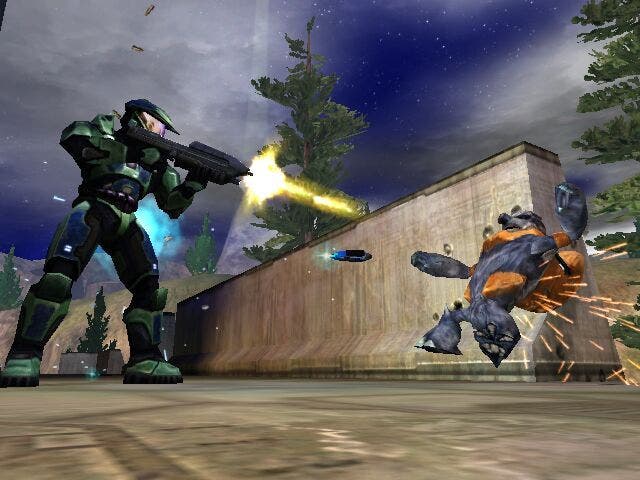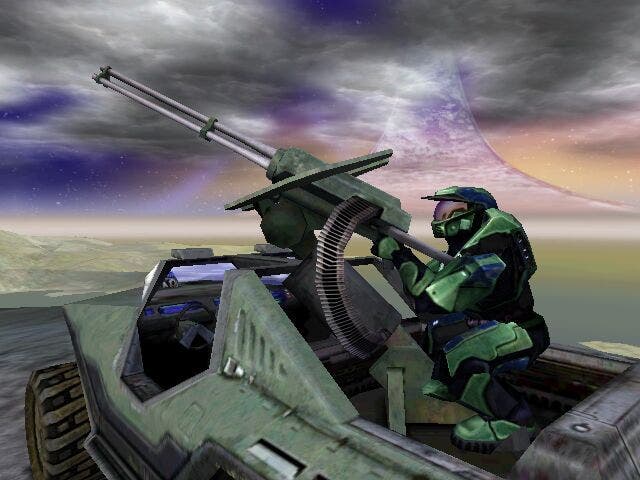Halo review
Eurogamer was 15 years old this week! Here's one of our most famous reviews.
Eurogamer turned 15 this week (happy birthday to us, etc!) and Bungie's latest game, Destiny, is due out on Tuesday, so when we were considering which article to drag out of the archive this weekend there really was only one choice. Eurogamer's launch editor John "Gestalt" Bye (we all had nicknames back then) penned this famous critique of Halo: Combat Evolved way back in the day, which left us with a legacy of "Better than Halo?" comments directed at any other review with a high score forever after. Always with the wit.
Read on to see what John made of Halo when he published this review on 13th March 2002, the eve of the original Xbox's European launch. Having worked with John in the early days of the site, I'd like to apologise to him should he happen upon this relic for going through and adding a few more hyphens than he would have liked, but I will preserve his strange love of incomplete ellipses floating in space. -Tom B
Breathless
Of all the games in the Xbox's European launch line-up, Halo is perhaps the nearest the console comes to having a killer app. It's the biggest-selling Xbox title to date in America, and the press on the other side of the pond have been raving about it for months. Now that it's finally arrived here in Europe, the question is, can it live up to the hype? And the answer is yes .. and no.

Halo puts you in the boots of a futuristic cyborg soldier known only as the Master Chief, and as the game begins you are being defrosted from cryogenic storage aboard a warship pursued by an alliance of alien religious fanatics called the Covenant. Luckily there's time for the engineers to power up your mobile armour suit and run you through some diagnostic tests first though, which gives you a chance to get to grips with the game's controls. Although I normally have difficulties with console shooters, Halo proved to be surprisingly easy to control, and the cinematic introductory sequences mean that you have several minutes to just run around admiring the scenery before having to actually shoot anything.
Indeed, the opening sections of Halo come across as the bastard offspring of Unreal and Half-Life. Having completed your test run you must make your way to the bridge to talk to the captain, without the benefit of a weapon and getting only glimpses of the enemy as battles rage in side corridors and behind doors which are wedged half open. Even when you finally get hold of a weapon and join in the action for yourself, the atmosphere doesn't let up as you make a dash for the last remaining lifepod, fighting alongside scattered squads of human marines as Covenant boarders try to block your escape route.
Bright Light City
All of this pales into insignificance when you finally touch down on the mysterious ring which gives the game its title. With the surface of the vast orbiting Halo arcing into the sky above your head and grass-covered mountains towering all around you, the scenery is spectacular to say the least.
Not that you'll have long to stand gawping at the view, as the Covenant are soon joining you on the surface to search for survivors. Guided by the soothing voice of the ship's female AI, entrusted to your protection by the captain, you soon find yourself roped into tracking down the other lifepods that escaped your ship and helping the marines to fight off Covenant forces long enough for a dropship to arrive and evacuate them. We won't spoil the rest of the game for you, but suffice to say that there are plenty of plot twists and dramatic in-game cut-scenes to keep you amused over the course of Halo's 10 missions.

The one downside to this heavily scripted story-led malarkey is that the game is depressingly linear at times, shuffling you from one encounter to the next and rarely giving you any real choice in where to go or what to do. While running around space ships and Halo's interior you will find an amazing wealth of locked doors which keep you from straying from the one true path, with occasional neon arrows conveniently painted on the floor to point you in the right direction in case there was any doubt. The outdoor settings look fairly open at first sight, but although there's more freedom of movement there are still only one or two paths open to you most of the time thanks to steep-sided canyons and the occasional rock fall.
Superstars In Their Own Private Movie
It's easy to forgive Halo these shortcomings for the first few hours though as it sucks you into a gorgeously rendered sci-fi world of bizarre aliens, curvaceous architecture and gaudy weapon effects. Halo is one of the most visually impressive games we've seen to date, and the only real problem on the eye candy front is an over-reliance on shiny metallic surfaces, giving it a slightly fake CG look in places.
The AI is equally strong, with the Covenant using cover and grenades to full effect, while groups of marines work together to cut them down, calling out directions as they track down stragglers. It's not perfect, and the enemy is a little passive at times, often allowing you to duck back behind cover and wait for your shields to recharge instead of pressing the attack. We were also a little alarmed at the frequency of friendly fire incidents in confined areas, although your men do at least apologise if they shoot one of their own. This constant chatter from both sides all adds to the atmosphere, and there's something undeniably satisfying about seeing a panicked Covenant grunt running away from you with his arms waving frantically in the air, shouting "he's unstoppable" and "they're everywhere".
If you want to do some screaming of your own, Halo features a full co-operative mode, allowing you and a friend to fight your way through the campaign side by side. It's a rare luxury these days, but one which adds a lot to the game's replay value. Naturally the game also includes the usual deathmatch and capture the flag modes, as well as king of the hill, checkpoint races and "oddball", where you get points for holding on to a ball for as long as possible. Apart from co-op (which only works with two players) all of these modes support up to four players, either on one Xbox with a split-screen view or with multiple Xboxes networked together using the built-in ethernet adapter. Things can get a little choppy at times with more than one player sharing the same screen, but overall it works well. If you're feeling really adventurous, it's even possible to play over the internet by hooking your Xbox up to a PC running some (very unofficial) third-party software.
Say What You Want

Halo isn't without its faults though. For starters, those of us weened on PC shooters may find it a little frustrating that you can only carry two guns at a time. As the game uses a checkpoint-based autosave system, if you find you have the wrong weapon for the job your only choices are either to run back to wherever you dropped the gun you really need now, or to muddle through as best you can.
And while most of the game is spent fighting on foot, often alone behind enemy lines, the small selection of vehicles which you get to drive from time to time aren't quite as satisfying. A combination of slightly awkward controls, low gravity and incredibly soft suspension makes the buggy in particular a real pig to drive on uneven surfaces. Maybe I just need more practice, but the single-player game doesn't really offer much opportunity to get the hang of driving and flying the various vehicles, except when you're in a hurry to get somewhere and getting shot from all directions.
Where Halo really falls down though is the pacing. The first few hours of the game is a work of unadulterated genius, constantly throwing new sights, enemies and weapons at you. But things go rapidly downhill from there on in. Suddenly you find yourself spending more time beneath the surface of Halo than above it, and most of these underground facilities are made up of a handful of drab prefab rooms repeated over and over again, with different combinations of monsters thrown in to block your way, and big glowing plot arrows in every room to point you through the one and only exit. Needless to say, clearing level after utterly linear level of near identical rooms soon gets tedious in some of these missions, especially when you find yourself forced to backtrack across a couple of miles of terrain that you've already explored at one point, with only a change of inhabitants to keep you interested. The game does at least pick up again at the end for an exciting finale, but by this point finishing the game may have become more of a chore than a delight for you.
Conclusions
Halo is very much a game of two halves. The first half is fast, exciting, beautifully designed and constantly full of surprises. The second half is festooned with gobsmacking plot twists and great cinematics but let down by repetitive, paint-by-numbers level design. Bungie could quite comfortably have cut several overly lengthy sections from this second half and still ended up with a respectably time-consuming game while maintaining the adrenaline-pumping pace of the first few hours. As it is Halo is a flawed masterpiece, one which is well worth owning but which may start to grate after a while.









